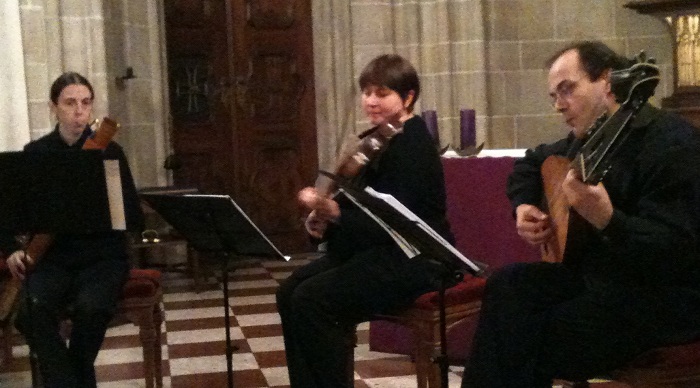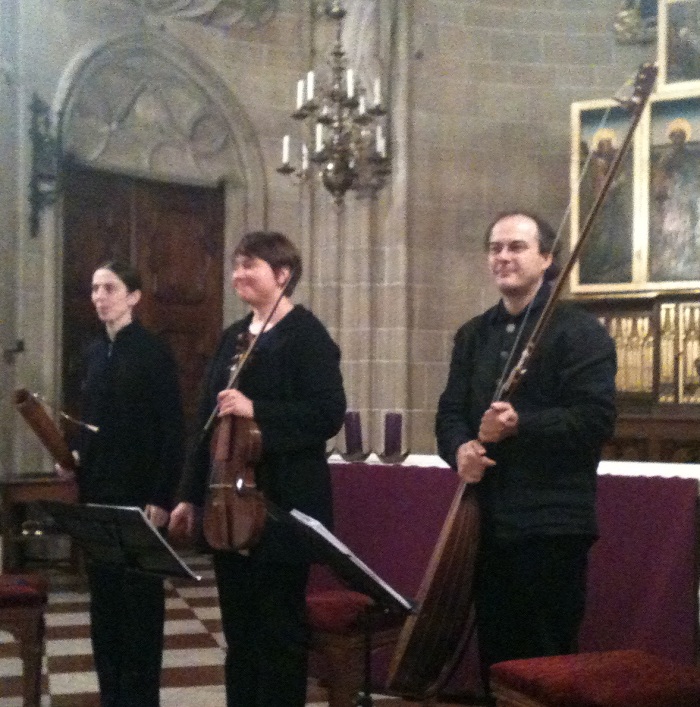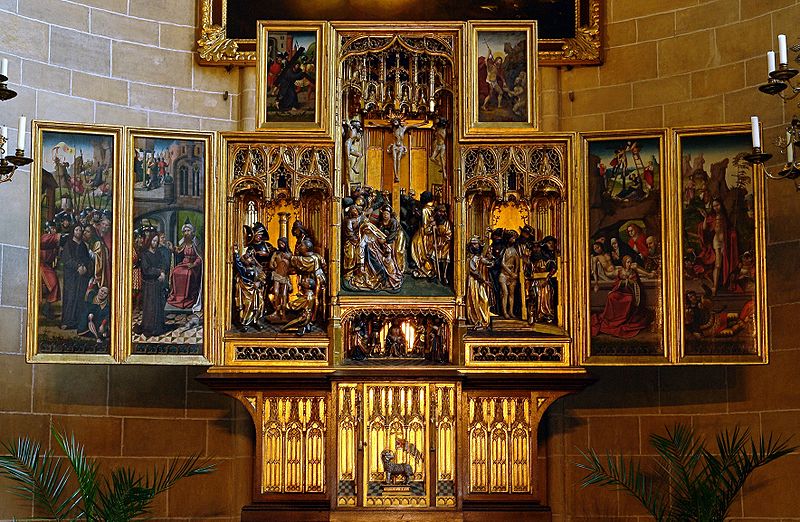 E arly music trio last night at Deutscherordenkirche Wien was really excellent.
E arly music trio last night at Deutscherordenkirche Wien was really excellent.- Katharine Mandl, Fagott / Dulcian
- Elzbieta Sajka, Violetta / Viola da braccio
- Hermann Platzer, Theorbe
- Bartolomeo de Selma y Salaverde (1595-1638) - Canzon a due tenori (alto dulcian; viola da braccio; theorbo)
- Johann Hieronymus Kapsberger (1580-1648) - Toccata nona und Passacaglia für Theorbe Solo
- Adam Jarzębski (1590-1648) - Cantata Giovanni Gabrielli
- Selma y Salaverde - Sonata Vestiva i colli für Dulcian Solo (with Theorbo continuo)
- Jarzębski - Concerto secondo
- Alessandro Piccinini (1566-1638) - Toccata XII, Gagliarda III, und Chiaccona in partite variate für Theorbe Solo
- Giovanni Battista Fontana (1571-1630) - Sonata nona
- Philipp Friedrich Böddecker (1607-1683) - Sonata “La Monica”
D ulcian is a precursor to the modern bassoon. Ms. Mandl performed on two of them—a smaller alto one, plus a tenor one with a range similar to tenor sax. The trio achieved a fine balance and blending of the timbres of dulcian, 5-stringed violetta / viola da braccio, and theorbo (lute).
T he dulcian part in the Böddecker is amazingly ornate and fast—performed over a languid dotted-quarter/eighth/quarter/quarter viola melody, accompanied by the theorbo continuo. The neume-like notation (which Ms. Mandl explained and illustrated in her pre-performance talk) is prolifically dense in its own right; however, the improvisational cadenzas that Mandl applied took this far beyond the densely-notated score. Truly virtuosic bassoon—on this tender, very old instrument. T he sanctuary at Deutschordenkirche is small and narrow—only about 10 meters wide. The consort last night positioned themselves near the altar, in a 60° circular-segment arrangement with chairs separated by about 1.5m. They recorded the performance using a Roland EDIROL R-44 4-channel digital recorder and two Schoeps MK-21 condenser microphones on a mic stand elevated 2.0m above the floor and angled downward 10° so that the mic axis of the left mic was midway between the dulcian and viola seats and the mic axis of the right mic was midway between the viola and theorbo seats. This distance to the instruments is a good compromise for these pieces—enough separation and directivity for the solo passages and appropriate lower-directivity for the tutti playing, so the listener’s attention is not confronted by unnatural left-right contrasts.
T he sanctuary at Deutschordenkirche is small and narrow—only about 10 meters wide. The consort last night positioned themselves near the altar, in a 60° circular-segment arrangement with chairs separated by about 1.5m. They recorded the performance using a Roland EDIROL R-44 4-channel digital recorder and two Schoeps MK-21 condenser microphones on a mic stand elevated 2.0m above the floor and angled downward 10° so that the mic axis of the left mic was midway between the dulcian and viola seats and the mic axis of the right mic was midway between the viola and theorbo seats. This distance to the instruments is a good compromise for these pieces—enough separation and directivity for the solo passages and appropriate lower-directivity for the tutti playing, so the listener’s attention is not confronted by unnatural left-right contrasts. T he wide off-axis response of this mic helps to blend adjacent instruments and enhance ensemble-ness. The 48-volt phantom-power Schoeps CMC-6 preamps (matched pair; one on each mic) are designed to be compatible with really long mic cables—as was the case last night with the EDIROL R-44 placed at one side of the sanctuary. The R-44 uses multi-gigabyte miniature camera-type SD cards or larger-capacity SDHC cards as the recording media and offers 24-bit wide A-to-D conversion and sampling frequencies (44.1KHz/48KHz/88.2KHz/96KHz/192KHz).
T he MK-21 Schoeps mics have a ‘subcardioid’ (wide cardioid) pattern—moderately high directionality and pretty flat frequency response. A pair of them currently costs about USD$3,500 new, and the R-44 is currently under USD$1,000. Mr. Platzer and Ms. Mandl easily set all the mics and recording equipment up within just two or three minutes before the program commenced, switched the EDIROL on, and so began the group’s performance: no muss, no fuss.
W e eagerly purchased 3 of the CDs that were available at last night’s performance (recordings made in 2007, 2009, and 2010, in Deutschordenkirche—which you can order off the group’s website [link below]). The sound imaging that they achieve with these nice mics and this set-up is phenomenally warm and detailed… heartily to be recommended to other early music groups who wish to capture high-quality sound of period instruments without tremendous worry or logistical troubles.
B ravo, for the live performance and for these excellent recordings!

- Pandolfis Consort Wien website
- Piccini Chiaccona score at IMSLP
- Facsimile scores for 16th and 17th Century dulcian compositions at Dulcians.org (Hans Mons)
- Schoeps wide-cardioid mikes
- Roland EDIROL R-44 4-channel digital recorder
- Deutscherordenkirche Wien


No comments:
Post a Comment